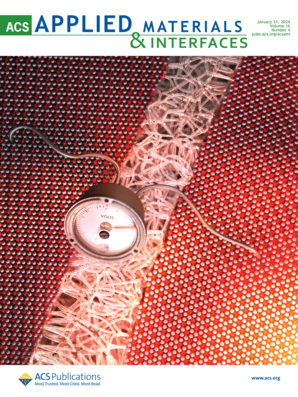Label-Free Electrochemical Interleukin-6 Sensor Exploiting rGO-Ti3C2Tx MXene Nanocomposites.
IF 8.3
2区 材料科学
Q1 MATERIALS SCIENCE, MULTIDISCIPLINARY
引用次数: 0
Abstract
This work introduces a novel, rapid, label-free, affinity-enabled electrochemical sensor for the detection of interleukin-6 (IL-6), a critical proinflammatory cytokine associated with severe conditions like sepsis and COVID-19. Unlike conventional approaches, this platform leverages an innovative biofunctional nanocomposite of Ti3C2Tx MXene, tetraethylene pentaamine-functionalized reduced graphene oxide (TEPA-rGO), and Nafion, functionalized with anti-IL-6 antibodies, integrated into a carbon-based screen-printed three-electrode chip. The system achieves unprecedented sensitivity in IL-6 quantification, with a single-digit pg/mL detection limit and a broad range of 3-1000 pg/mL using ∼5 μL of serum. The sensor design is uniquely enhanced through the introduction of a genetic algorithm-based thin-layer diffusion model, which optimizes critical, previously unknown electrochemical transport parameters, including diffusion coefficient, rate constant, charge transfer coefficient, and electrochemically active surface area. This approach represents a significant advancement in biosensor modeling and performance tuning. The sensor demonstrates exceptional selectivity (signal-to-noise ratio ∼ 6.9) against relevant interferents (e.g., sepsis-related antigens, small molecules, electroactive compounds), retains operational stability for a month, and offers a sample-to-answer time of ∼15 min (i.e., up to 12 times faster than traditional ELISA), while maintaining comparable sensitivity. Detailed morphological, topographical, and chemical analyses validate the structural and functional integrity of the TEPA-rGO/MXene/Nafion nanocomposite. By combining cutting-edge nanomaterials with advanced computational modeling, this IL-6 sensor sets a new benchmark for rapid, precise cytokine detection, offering transformative potential for early disease diagnosis and prognosis.利用rGO-Ti3C2Tx MXene纳米复合材料的无标记电化学白细胞介素-6传感器
这项工作介绍了一种新型、快速、无标签、亲和的电化学传感器,用于检测白细胞介素-6 (IL-6), IL-6是一种与脓毒症和COVID-19等严重疾病相关的关键促炎细胞因子。与传统方法不同,该平台利用了一种创新的生物功能纳米复合材料Ti3C2Tx MXene,四乙烯五胺功能化还原氧化石墨烯(TEPA-rGO)和抗il -6抗体功能化的Nafion,将其集成到碳基丝网印刷三电极芯片中。该系统在IL-6定量中具有前所未有的灵敏度,检测限为个位数pg/mL,使用~ 5 μL血清时检测范围为3-1000 pg/mL。通过引入基于遗传算法的薄层扩散模型,该传感器的设计得到了独特的增强,该模型优化了以前未知的关键电化学传输参数,包括扩散系数、速率常数、电荷转移系数和电化学活性表面积。这种方法代表了生物传感器建模和性能调整方面的重大进步。该传感器对相关干扰(如败血症相关抗原、小分子、电活性化合物)表现出卓越的选择性(信噪比~ 6.9),保持一个月的操作稳定性,并提供样品到答案时间为~ 15分钟(即比传统ELISA快12倍),同时保持相当的灵敏度。详细的形态学、地形学和化学分析验证了TEPA-rGO/MXene/Nafion纳米复合材料的结构和功能完整性。通过将尖端纳米材料与先进的计算模型相结合,这种IL-6传感器为快速、精确的细胞因子检测设定了新的基准,为早期疾病诊断和预后提供了变革性的潜力。
本文章由计算机程序翻译,如有差异,请以英文原文为准。
求助全文
约1分钟内获得全文
求助全文
来源期刊

ACS Applied Materials & Interfaces
工程技术-材料科学:综合
CiteScore
16.00
自引率
6.30%
发文量
4978
审稿时长
1.8 months
期刊介绍:
ACS Applied Materials & Interfaces is a leading interdisciplinary journal that brings together chemists, engineers, physicists, and biologists to explore the development and utilization of newly-discovered materials and interfacial processes for specific applications. Our journal has experienced remarkable growth since its establishment in 2009, both in terms of the number of articles published and the impact of the research showcased. We are proud to foster a truly global community, with the majority of published articles originating from outside the United States, reflecting the rapid growth of applied research worldwide.
 求助内容:
求助内容: 应助结果提醒方式:
应助结果提醒方式:


